Thalassemia, an inherited quantitative globin disorder, consists of two types, α– and
β–thalassemia.
β–thalassemia is a heterogeneous disease that can be asymptomatic, mild, or even severe. Considerable research has focused on investigating its underlying etiology. These studies found that DNA hypomethylation
[...] Read more.
Thalassemia, an inherited quantitative globin disorder, consists of two types, α– and
β–thalassemia.
β–thalassemia is a heterogeneous disease that can be asymptomatic, mild, or even severe. Considerable research has focused on investigating its underlying etiology. These studies found that DNA hypomethylation in the β–globin gene cluster is significantly related to fetal hemoglobin (HbF) elevation. Histone modification reactivates γ-globin gene expression in adults and increases β–globin expression. Down-regulation of γ–globin suppressor genes, i.e.,
BCL11A,
KLF1,
HBG-XMN1,
HBS1L-MYB, and
SOX6, elevates the HbF level.
β–thalassemia severity is predictable through
FLT1,
ARG2,
NOS2A, and
MAP3K5 gene expression.
NOS2A and
MAP3K5 may predict the
β–thalassemia patient’s response to hydroxyurea, a HbF-inducing drug. The transcription factors NRF2 and
BACH1 work with antioxidant enzymes, i.e.,
PRDX1,
PRDX2,
TRX1, and
SOD1, to protect erythrocytes from oxidative damage, thus increasing their lifespan. A single
β–thalassemia-causing mutation can result in different phenotypes, and these are predictable by
IGSF4 and
LARP2 methylation as well as long non-coding RNA expression levels. Finally, the coinheritance of
β–thalassemia with α–thalassemia ameliorates the
β–thalassemia clinical presentation. In conclusion, the management of
β–thalassemia is currently limited to genetic and epigenetic approaches, and numerous factors should be further explored in the future.
Full article






